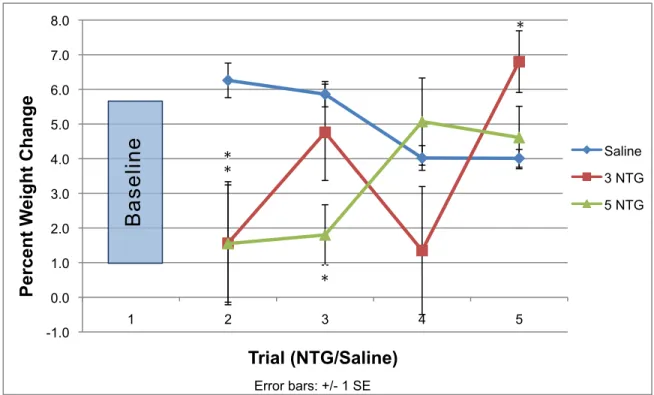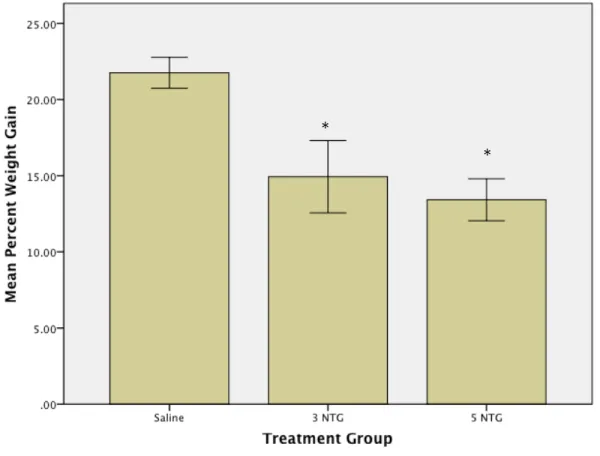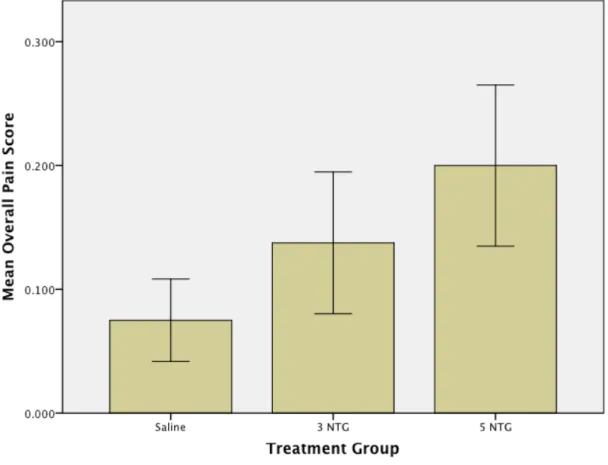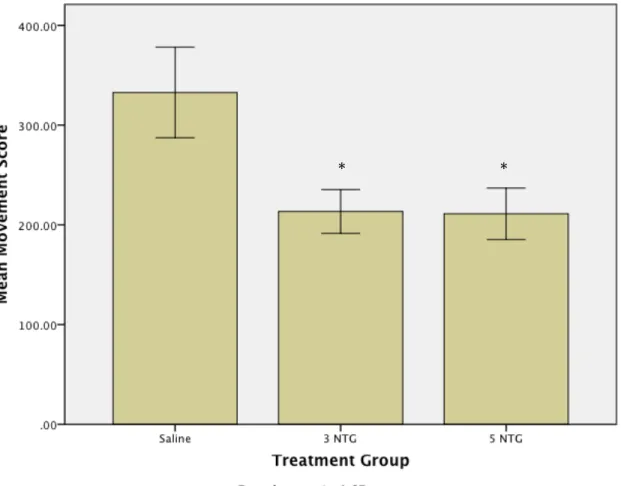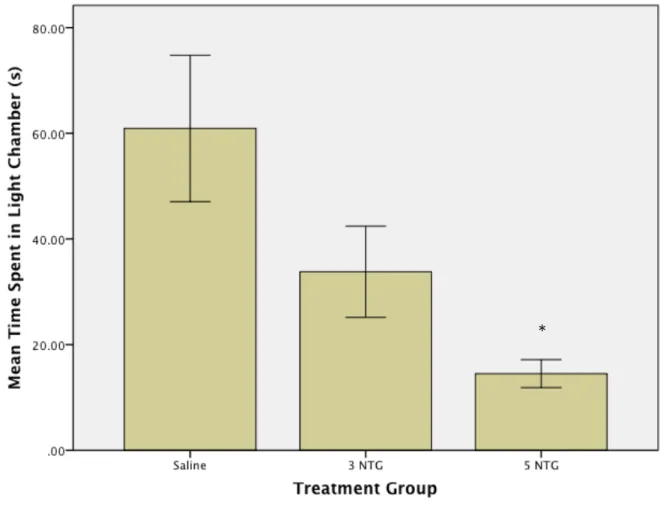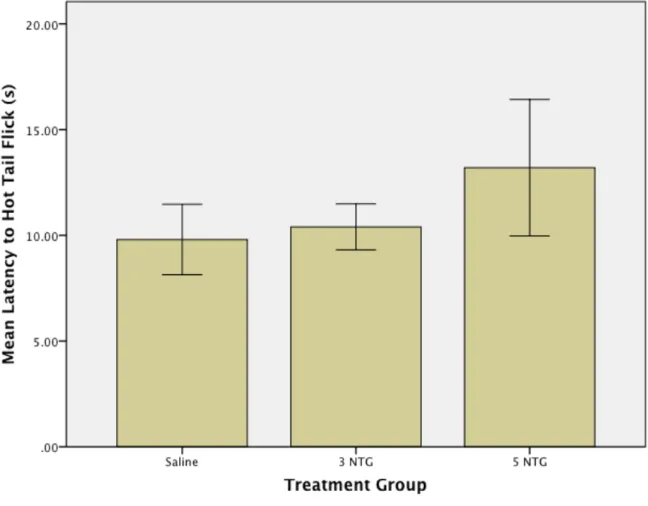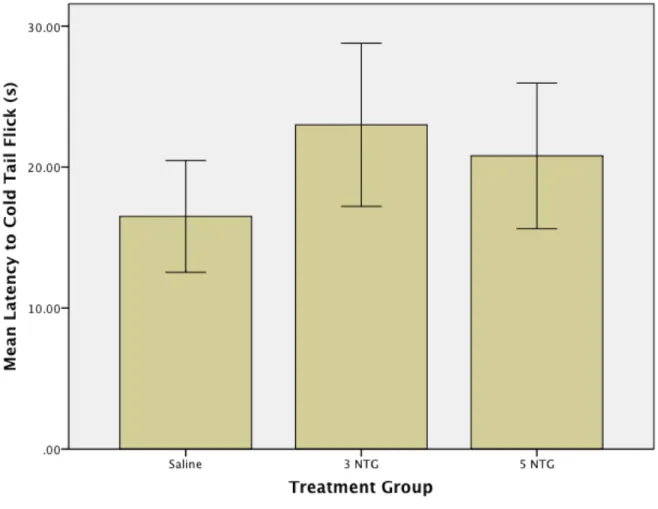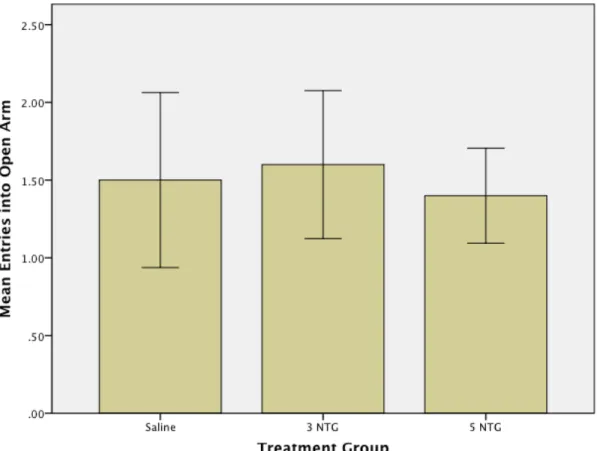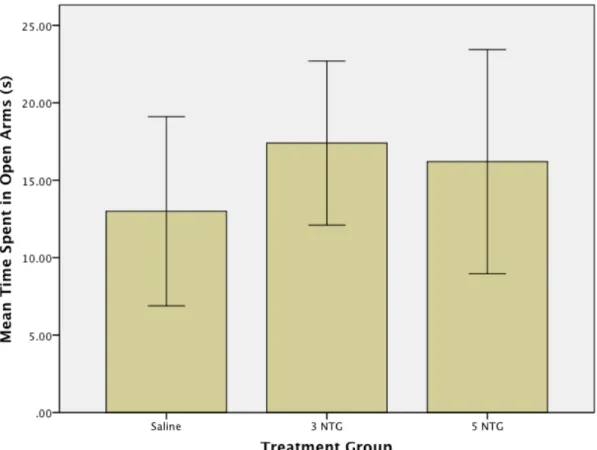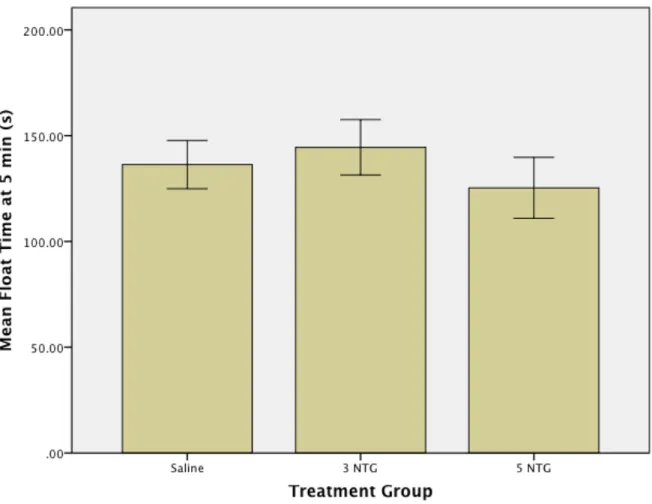Repeated administration of NTG affected weight gain, locomotion in the modified light/dark box, and photophobia. While acute migraine treatments are somewhat effective in reducing migraine pain, they do not reduce the likelihood of future attacks (Silberstein, 2004). Overuse of acute medications to relieve migraine pain is also a common problem because it can lead to a significant increase in the frequency of migraine attacks (Katsarava, Limmroth, Finke, Diener & Fritsche, 2003).
The preventative or prophylactic class of migraine treatments are designed to reduce the likelihood of migraine attacks occurring in the future. One study has investigated the effect of NTG on the more clinically relevant endpoint of allodynia in mice (Bates et al., 2010). Movement in the modified light/dark box was significant, but contrary to our predictions, treatment animals achieved higher movement scores than control animals.
To address these methodological issues in this study, we developed two recurrent migraine conditions. We hypothesized that animals receiving either 3 or 5 episodes of NTG migraine would score higher on the rat grimace scale, spend less time in the light chamber of the modified light/dark box, exhibit less locomotion, and exhibit shorter collision latencies the tail. in thermal tail-flick tests than in animals that did not experience NTG migraine episodes. Another goal of this study was to determine whether animals that experienced multiple migraine episodes exhibited the comorbidity of anxiety and depression that many people with migraine experience and that most commonly occur in.
We hypothesized that animals receiving 3 or 5 NTG migraine episodes would enter the open arms less often and spend less time in the open arms than control animals.
Materials and Methods
Two hours after the 5th NTG or saline administration, rats were taken to the procedure chambers and run through a series of tests. It included a picture of the rat's face to quantify the rat grimace scale, a modified light/dark box test, and two nociceptive tests. The next day, rats were tested on the elevated plus maze in the morning and the forced swim test in the afternoon.
The top of the white room remained uncovered to create a light and dark environment in the same apparatus. Following their RGS photograph, rats were transferred directly from the RGS box to the gray chamber of the modified light/dark box. They were left in the gray room with the guillotine doors down for 1 minute to acclimatize.
On the test day, the rats were wrapped in a towel and their tails were immersed to the 5 cm mark in a hot or cold water bath. The tests were counterbalanced for order, and the rats were returned to their home cages after this test. The morning after the last NTG administration, rats were tested on the elevated plus maze to quantify anxiety-like behavior.
Rats were transferred from their home cage directly to the treatment room and placed in the center of the maze, facing an open arm. The test session lasted 5 minutes and two dependent measures were recorded: the number of entries into the open arms and the time spent in the open arms. Four hours after testing in the elevated plus maze, rats were given a forced swim test to quantify depression or behavioral despair.
Rats from the same home cage were simultaneously placed in the cylinders and observed for 10 min. All attempts to escape, including vigorous swimming and going underwater to explore the cylinder, were considered wrestling behavior and were not included in the floating time measurement. After the testing session ended, the rats were removed from the apparatus and dried with microfiber towels before returning to their cage.
Results
The mean locomotion score for the control group was 332, while the score for the treatment groups was approximately 212. Post hoc analyzes showed that the 3 and 5 NTG groups had significantly lower locomotion scores than the control group (ps. Effects of NTG administration on altered the light/dark field is summarized in Figure 4.
Control animals spent 61 seconds in the apparatus' light chamber, while the 3 NTG group spent 34 seconds and the 5 NTG group spent 14 seconds. Post hoc analyzes revealed that the difference seen in the 3 NTG group approached significance compared to the control group (p = 0.055) and that the 5 NTG group spent significantly less time in the light chamber than the control group (p = 0.005). The mean latency to tail movement of the control group was 9.8 seconds, while that of the 3 NTG group was 10.4 seconds and that of the 5 NTG group was 13.2 seconds.
The mean latency to tail flick for the control group was 16.5 seconds, while that of the 3 NTG group was 23 seconds and that of the 5 NTG group was 20.8 seconds. The control group averaged 1.5 participations in the open arms, while the 3 NTG group averaged 1.6 participations and the 5 NTG group averaged 1.4 participations. The control group spent an average of 13 seconds in the open arms, while the 3 NTG group spent 17.4 seconds and the 5 NTG group spent 16.2 seconds.
The control group floated for an average of 136 seconds, while the 3 NTG group floated for 145 seconds and the 5 NTG group floated for 113 seconds. The control group floated for an average of 420 seconds, while the 3 NTG group floated for 424 seconds and the 5 NTG group floated for 362 seconds.
Discussion
There are no existing data on RGS scores in the NTG migraine model, but the fact that our scores were consistent with this laboratory's previous work demonstrates the reliability of the RGS to consistently predict pain during NTG migraine episodes. These findings suggest that the Rat Grimace Scale is reliable and a clinically valid tool for assessing pain in the NTG migraine model. As we predicted, both 3 and 5 NTG migraine episodes reduced locomotion compared to animals that did not receive NTG migraine episodes.
This confirms the worsening of migraine pain with movement in this model, which is also seen in the human clinical profile. These results are in contrast to the previous studies from this laboratory, which showed that a single NTG migraine episode increased locomotion. This is the first research to our knowledge to confirm motion sensitivity during an NTG migraine episode.
This trend was more robust in the 5 NTG group, which spent significantly less time in the light room than the control group, consistent with our predictions. This would account for the more robust photophobia displayed in the 5 NTG group than the 3 NTG group. To our knowledge, this is the first evidence of photophobia in an NTG migraine model.
Our recurrent migraine model with a maximum of 5 NTG migraine episodes does not approach an attack. Although these results are somewhat disappointing, we might not expect symptoms of anxiety and depression after only 5 episodes of NTG migraine. The recurrent NTG migraine model yields two of the most clinically relevant behavioral endpoints for human migraine: motion sensitivity and photophobia.
Several analyzes have suggested additional homologies to human migraine, including reduced weight gain, which we attributed to nausea, and pain expression on the mice grimace scale. This follows the clinical picture as allodynia and associated disorders are more commonly seen in the chronic migraine state. While these results support the NTG migraine model, the most clinically relevant endpoints determined in the current study should be altered by sumatriptan to strengthen the validity of this model.
The reduction in time spent in the light chamber in the three NTG group approached significance (p = 0.055). Five administrations of NTG significantly reduced the time spent in the light chamber, indicating the presence of photophobia (p = 0.005).
